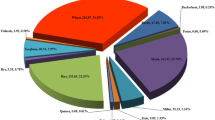Summary
On the basis of data from the literature, a survey of the occurrence and mode of inheritance of male sterility in a large number of plant species is presented (Table 1).
The importance of male sterility as a means of breeding heterosis varieties is indicated and the advantages attached to the use of MS, and the problems arising from it, are discussed.
It is contented that the rarely occuring types of plasmatically inherited MS offer good possibilities of utilization in the case of cross fertilized plants. The procedure to be adopted in using this type of MS is described in considerable detail in § 5 and 8.
It is regretable that, in self-fertilized field crops under conditions of natural pollination, the small seed set obtained presents serious difficulties in breeding hybrids on a scale which is commercially justified. In horticulture, however, where artificial pollination can be made to pay, hybrids have already been created with the aid of MS types possessing a monofactorial recessive system of inheritance and have been put on the market. The procedure adopted is described in § 9.
A survey is given of the results already obtained with MS in tomato, onion, sugar beet and maize, and it is anticipated that important increases in yield may also be obtained in other cross fertilized plants and self-fertilized horticultural crops with the aid of MS.
Samenvatting
Aan de hand van literatuurgegevens werd een overzicht gegeven van het voorkomen en de wijze van vererving van mannelijke steriliteit in een groot aantal plantensoorten. (tabel 1).
Gewezen werd voorts op de betekenis van mannelijke steriliteit als hylpmiddel bij het kweken van heterosisrassen, terwijl de aan het gebruik van MS verbonden voordelen en de zich daarbij voordoende problemen werden besproken.
Betoogd werd dat de schaars voorkomende typen van plasmatisch verervende MS goede toepassingsmogelijkheden bieden voor gebruik in kruisbevsuchters; de bij het benutten van dit type MS te volgen werkwijze werd uitvoerig aangegeven in de paragrafen 5 en 8.
Helaas vormt in zelfbevruchtende akkerbouwgewassen bij natuurlijke bestuiving de geringe zaadzetting van MD planten een ernstig beletsel voor het op commericeel verantwoorde wijze kweken van hybriden; in de tuinbouw, waar men veelal kunstmatige bestuiving rendabel kan maken, werden echter met behulp van monofactorieel recessief verervende vormen van MS reeds hybriden verkregen en in het verkeer gebracht. De hierbij gevolgde werkwijze werd beschreven in paragraaf 9.
Een overzicht werd gegeven van de reeds met behuop van MS bereikte resultaten bij tomaat, ui, suikerbiet en mais, terwijl de verwachting werd uitgesproken dat ook bij andere kruisbevruchters, zelfbevruchtende tuinbouwgewassen en tabak met behulp van MS nog belangrijke meeropbrengsten in de practijk te behalen zullen zijn.
Similar content being viewed by others
Literature cited
ArtschwagerE., Pollen degeneration in male sterile sugar beets with special reference to the tapetal plasmodium. J. Agr. Res.75 (1947): 191–197.
Ashton, T., The use of heterosis in the production of agricultural and horticultural crops. Commonw. Bur. Pl. Breeding; School of Agric. Cambridge, 2nd. impression 1949, 30 pp.
Banga, O., Inleiding tot de plantenveredeling. Zwolle 1953: 501–506.
Bauman, L. F., Progress report on genetic control of male sterility. Rep. 6th Hybrid Corn Ind. Res. Conf. Chicago, 1951: 13–18.
Ingersoll, F. S., Commercial application of cytoplasmic male sterility. Rep. 6th Hybrid Corn Ind. Res. Conf. Chicago 1951: 19–24.
JonesD. F. and EverettH. L., Hybrid field corn. Bull. Conn. Agric. Exp. Sta.532 (1949): 35–39.
JonesH. A. and ClarkeA. E., Inheritance of male sterility in the onions and the production of hybrid seed. Proc. Am. Soc. Hort. Sci.43 (1943): 189–194.
JonesH. A. and DavisG. N., Inbreeding and heterosis and their relation to the development of new varieties of onions. U.S.D.A. Techn. Bull.874 (1944): 1–28.
JosephsonL. M. and JenkinsM. T., Male sterility in corn hybrids. J. Am. Soc. Agron.40 (1948): 267–274.
Jungenheimer, R. W., Evaluation of genetic male sterility in the hybrid corn program. Rep. 6th Hybrid Corn Ind. Res. Conf. Chicago 1951: 25–28.
KohlsH. L., Hybrid sugar beets in Michigan. Quart. Bull. Mich. Agric. Exp. Sta.31 (1949): 406–408.
OwenF. V., Utilization of male sterility in breeding superior yielding sugar beets. Proc. Am. Soc. Sugar Beet Technol. Gen. Meeting5 (1948): 156–161.
OwenF. V., The sugar beet breeders problem of establishing male sterile populations for hybridization purposes. Proc. Am. Soc. Sugar Beet Technol. Gen. Meeting6 (1950): 191–194.
RickC. M., Field identification of genetic male sterile tomatoplants for use in producing F1 hybrid seed. Proc. Am. Soc. Hort. Sci.46 (1945): 277–283.
RogersJ. S. and EdwardsonJ. R., The utilization of cytoplasmic male sterile inbreds in the production of corn hybrids. J. Am. Soc. Agron.44 (1952): 8–13.
StephensJ. C., Cytoplasmic male sterility for hybrid sorghum seed production. J. Am. Soc. Agron.46 (1954): 20–23.
Author information
Authors and Affiliations
Additional information
The author wishes to thank Prof. Dr R.Prakken for his kind permission to publish this study which has been carried out under his direction, and is grateful to Prof. Dr J. C.Dorst for his helpful criticism.
Rights and permissions
About this article
Cite this article
Van Der Kley, F.K. Male sterility and its importance in breeding heterosis varieties. Euphytica 3, 117–124 (1954). https://doi.org/10.1007/BF00029958
Received:
Issue Date:
DOI: https://doi.org/10.1007/BF00029958




